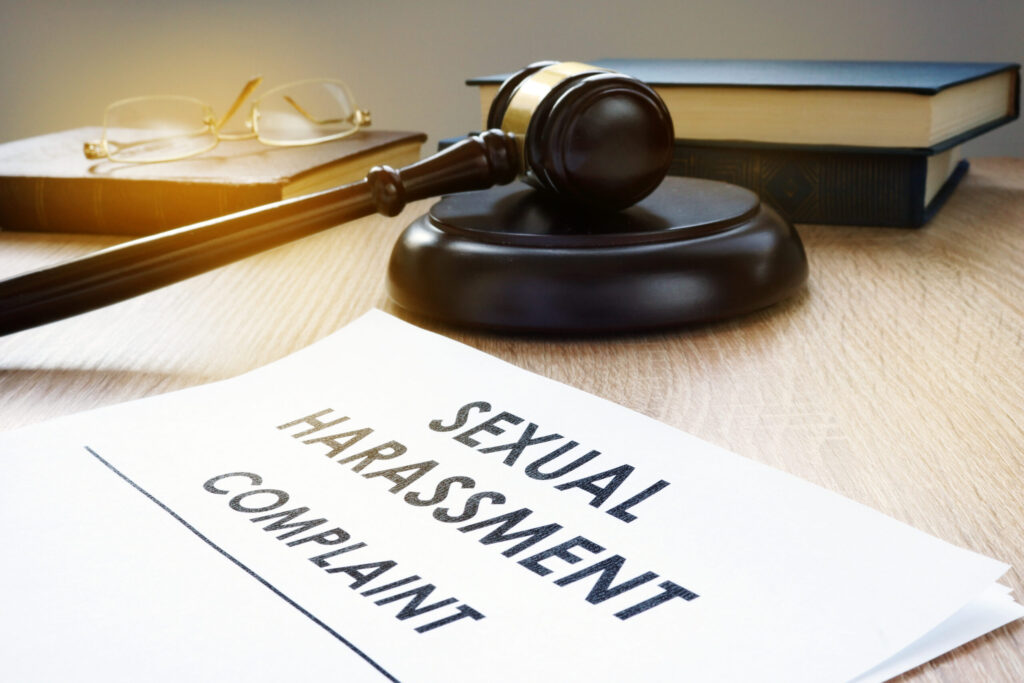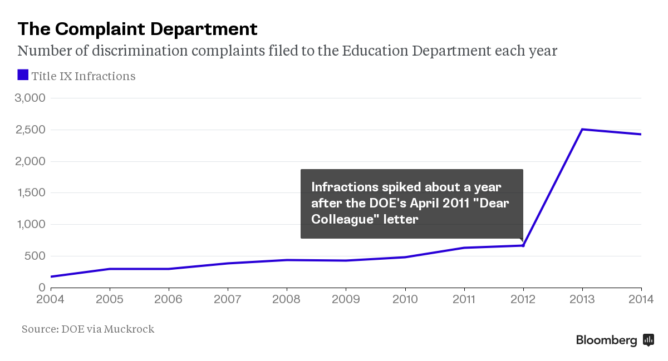Signed by President Nixon in 1972, Title IX of the Education Amendments of 1972 states that “no person in the United States shall, on the basis of sex, be excluded from participation in, be denied the benefits of, or be subjected to discrimination under any education program or activity receiving Federal financial assistance.”
This civil rights legislation prohibits federally funded schools from restricting admission or participation in activities based on sex. As far as sports are concerned, the legislation requires that male and female students be given equal opportunity to participate. Schools found to be in violation of Title IX could suffer loss of federal funding.
U.S. Department of Education Title IX Final Rule: Addressing Allegations of Sexual Harassment
The Final Rule, under Title IX, which was released in May 2020, declares that sexual harassment and sexual assault are unlawful sex discrimination, and it requires schools to respond equitably and promptly to sexual misconduct incidents. The Final Rule prescribes a consistent and transparent grievance process for resolving formal complaints of sexual harassment.
Sexual Harassment, for purposes of the Final Rule under the Title IX Regulations includes the following sexual activity, which is also considered sex discrimination:
- Any unwelcome sexual conduct, including unwelcome sexual advances, requests for sexual favors, and other verbal, nonverbal or physical conduct of a sexual nature
- Physical sexual acts perpetrated against a person’s will or where a person is incapable of giving consent
- Acts of verbal, nonverbal, or physical aggression, intimidation, or hostility based on sex or sex-stereotyping, even if those acts do not involve conduct of a sexual nature
Sexual harassment under Title IX is unwelcome sexual conduct determined by a reasonable person to be so severe, pervasive and objectively offensive that it effectively denies an individual equal access to a school’s education program or creates a hostile or abusive educational environment. Quid pro quo harassment, dating violence, and stalking are also considered forms of sexual harassment for the purposes of Title IX.
access to a school’s education program or creates a hostile or abusive educational environment. Quid pro quo harassment, dating violence, and stalking are also considered forms of sexual harassment for the purposes of Title IX.
Title IX requires schools to take the necessary steps to prevent and address sex-based harassment including sexual harassment, sexual violence and gender-based harassment. Sexual violence as defined by the Office for Civil Rights (OCR) includes rape, sexual assault, sodomy, sexual battery, sexual abuse and sexual coercion. Gender-based harassment is harassing behavior directed at a student who doesn’t conform to sex stereotypes (i.e., LGBTQ students).
Sex-based harassment can be directed at both males and females and can be perpetrated by faculty, staff members or other students.
What are Schools Required to do Under Title IX?
Title IX requires schools to have certain individuals and policies in place, including
- A policy against sex discrimination that is distributed and available, with the name and contact information for the Title IX Coordinator
- A Title IX Coordinator
- A policy that that states that the school does not discriminate on the basis of sex in its education programs and activities. The policy must state that any Title IX inquiry may be referred to the school’s Title IX coordinator or to the OCR.
- A fair and impartial grievance process that is published and available to all students
- Investigators and decision-makers who are required to serve without bias for or against the complainant or respondent
- A timeframe that includes when the school will complete a full investigation of the complaint, when the complainant and respondent will be notified of the disposition of the complaint, and when an appeal may be filed, if necessary. There may be circumstances that require the extension of time frames for good cause.
- Supportive measures for the complainant or respondent, who may be suffering from substantial emotional distress, including the issuance of an on-campus no-contact order to the perpetrator, changing the student’s class schedule, providing a campus escort, counseling, changing housing accommodations and extensions of schoolwork-related deadlines. These measures must be offered without fee to the complainant or respondent. They are designed to preserve equal access to the school’s education program or activity without unreasonable burden to either party.
Role and Responsibilities of the Title IX Coordinator
The Title IX Coordinator is responsible for coordinating the school’s compliance with Title IX. Schools must notify all students and employees of the name or title and contact information of the Title IX coordinator.
Responsibilities of the Title IX coordinator include overseeing all sex discrimination and sexual harassment/sexual violence complaints and identifying and addressing any patterns of behavior that arise during the review of these types of complaints.
A report to a Title IX coordinator may or may not result in a full-on investigation, depending on decisions made by the complainant.
Title IX Grievance Procedure Starts With a Formal Complaint
The grievance process involves the filing, investigation, hearing and possible appeal of a sexual harassment allegation.
The process begins when the complainant, or alleged victim of sexual harassment, registers a formal complaint of the alleged misconduct in writing that he or she signs along with the Title IX Coordinator. The formal complaint includes an allegation of sexual harassment and a description of the alleged incident (e.g., sexual harassment, sexual assault or sexual violence) along with the identities of the parties involved, including the respondent and any witnesses.
The complainant must be participating in or attempting to participate in the education program or an activity of the educational institution where he or she is filing the complaint.
Dismissal of a Formal Complaint
An educational institution must first investigate the alleged misconduct in the formal complaint and must dismiss the formal complaint for sexual harassment under Title IX if the alleged conduct:
- Would not constitute sexual harassment even if proven
- Occurred outside the United States
- Did not occur in the school’s education program or activity
The school may dismiss the formal complaint if:
- A complainant withdraws the formal complaint and notifies the Title IX Coordinator of the intent to withdraw in writing
- The respondent no longer works at or is enrolled at the school
- Circumstances do not allow the gathering of sufficient evidence to arrive at a determination
A dismissal does not preclude taking action under university policy or another provision of the school’s Code of Conduct.
Informal Resolution Process
Individuals may decide against going through a formal grievance process. The informal resolution process is a voluntary structured interaction, between or among the parties involved, that focuses on support and accountability. It allows the respondent to own up to the harm caused and the responsibility to repair the harm brought on the complainant.
Informal resolution is meant to eliminate the prohibited conduct and prevent it from reoccurring. It must also meet the complainant’s needs while ensuring the safety of the school community.
A formal complaint has to be filed in order for informal resolution to occur. A complainant can request it when the filing is made or at any time before the hearing takes place. Parties must consent to this procedure in writing and participation in the process is completely voluntary. An end to the informal resolution process can be requested at any time.
If informal resolution is unsuccessful, the investigation and grievance process will continue.
Steps in the Title IX Investigation/Grievance Process
From the date that the formal complaint is filed until resolution, the typical Title IX grievance procedure may take 30-60 business days. The Title IX Coordinator and Title IX Investigator will endeavor in good faith to ensure that the grievance process is completed promptly.
Step 1
After the Title IX Coordinator receives a written statement by the complainant, the parties in the complaint will receive notice of the school’s grievance process.
The complainant and respondent will also receive written notice of the allegations that may be determined to be sexual harassment, along with the details of the complaint, including:
- Identities of the parties involved in the complaint
- The alleged sexual harassment conduct
- The date(s) and location(s) of the alleged sexual harassment
- A statement that the respondent is not presumed to be responsible for the alleged conduct, and a written determination will be forthcoming at the conclusion of the grievance process
- Information that the parties may have an advisor of their own choosing, who may be an attorney, with the ability to inspect and review any evidence
If any additional allegations are made during the course of the grievance procedure, a notice of additional allegations must be sent to the parties involved.
Step 2
The Title IX Coordinator and/or the designated investigator will then review the allegations in the complaint ensuring that:
- There is equal opportunity for the parties to present witnesses
- There is no restriction on the ability of either party to discuss the allegations in the complaint or to gather and present evidence
- Each party has the same opportunity to have others present at any grievance proceeding, including an advisor of his/her own choice, which may be an attorney.
- Written notice of the date, time, location, participants and purpose of any investigation interview for gathering evidence will be sent to parties whose attendance is expected, with reasonable time for the party to prepare for participation
- There is an equal opportunity to inspect and review findings of fact/relevant evidence obtained during the investigation that is directly related to the allegations in the formal complaint. These will be delivered in electronic format or hard copy, so that each party can respond to the evidence prior to the investigation’s conclusion. Each party has at least 10 business days from receipt of the evidence to inspect, review and submit a written response to the evidence contained in the investigative report.
Step 3
Once the parties have had an opportunity to review evidence, the Title IX grievance process must provide for a live hearing with a decision-maker present. During the live hearing, each party’s advisor will be permitted to ask the parties and their witnesses relevant questions. There is also be an opportunity for cross-examination.
Decision-makers can also consider relevant information that is provided by absent or non-cross-examined parties or witnesses, including statements made during an investigation, email or text exchanges between the parties that led up to the alleged sexual harassment, or police reports and other medical documents (e.g., from a Sexual Assault Nurse Examiner).
Step 4
Prior to the decision being rendered, the respondent is presumed not to be responsible. This is also called the presumption of innocence. The school bears the burden of proof, therefore, and must correctly apply the standard of evidence in the grievance process.
Trained Title IX personnel must evaluate all relevant evidence objectively, without any prejudgment of the facts and without any conflicts of interest or bias toward either the complainant or the respondent.
The decision-maker cannot be the Title IX Coordinator or the investigator. The decision-maker will arrive at a decision based on either the preponderance of the evidence standard or the clear and convincing evidence standard. This is different that the “beyond a reasonable doubt” standard used in courts and jury trials.
After arriving at a decision, the decision-maker sends both parties simultaneously a written determination as to the outcome of the matter, explaining how the decision-maker arrived at his/her conclusion.
The written decision requires the following to be included:
- The identification of the allegations of sexual harassment
- The steps taken from receipt of the filing of a formal complaint through the final determination, including interviews with parties and witnesses, evidence that was gathered, notices to the parties and hearings
- Findings of fact that support the decision-makers conclusion
- Determination of responsibility
- Disciplinary sanctions/disciplinary action that the university will impose on the respondent
- Remedies that will be undertaken to restore the complainant’s equal access to the school’s education or activities
- Process for appeal by complainant or respondent
Step 5
An appeal may be requested if:
- A procedural irregularity affected the outcome
- New evidence, not previously available, was made available, and it was determined that it could affect the outcome
- The Title IX Coordinator, investigator or decision-maker is found to have had a conflict of interest or bias that affected the outcome
If an appeal is granted, the appeal process must:
- Provide written notice to the other party that an appeal has been filed
- Ensure that the decision-maker is not Title IX Coordinator, investigator or decision-maker in the preliminary hearing
- Ensure that the decision-maker is properly trained, free of bias and conflict of interest
- Allow both parties an equal opportunity to submit a written statement in support of or opposed to the original outcome
- Ensure that a written determination stating the outcome of the appeal and the rationale for the decision is presented simultaneously to both parties
Title IX Training
Title IX training educates students, faculty and staff members on the rights and responsibilities that they have to report and address any type of sexual misconduct in order to promote a safe, protected and respectful working and learning environment.
Training for Key Members of the Title IX Team
Key members of the Title IX team, including the Title IX Coordinator, investigators, hearing officers and decision-makers (including anyone who facilitates an informal resolution process) must receive Title IX training.
The training must cover:
- The definition of sexual harassment
- Title IX investigation protocols, including how to interview complainants
- Requirements for “consent” as it applies to sexual behavior and activities
- How to decide if a witness is credible
- Protecting confidentiality
- What bias is and what a conflict of interest looks like
- The fact that men as well as women can be victims of sexual misconduct
- The Title IX grievance process, including hearings, appeals and informal resolutions
- What a fair and impartial investigation looks like (for investigators)
- How to institute support measures for a complainant and the kinds of support available
- Cross-examination procedures (for hearing officers)
- Rape shield protections for complainants regarding questions and evidence of prior sexual activity and behavior (for hearing officers)
- The availability of separate rooms during hearings and the technology that should be employed
Annual training is recommended for refresher and to ensure that all Title IX personnel are aware of any new provisions/changes to Title IX processes and procedures.
Title IX Training for Students and Employees
All new students and employees should be trained in a program that promotes prevention and awareness of sexual harassment – what it is and what to do.
Training might include:
- Bystander intervention skills
- The definition of “consent” as it applies to sexual behavior and activities
- How and when to report an incident that involves discrimination or sexual harassment/assault/violence
- Why it’s important to preserve any physical evidence in a sexual violence incident
- Ways to recognize and avoid potential attacks and sexual abuse
- How and when law enforcement can become involved
Additional Resources
Although some of these reference “employee,” they can also be used for Title IX investigations.
- Blog: Title IX Needs to be More Than Just a Policy in a File
- Expert Webinar: Making the Call – How to Assess Credibility in Workplace Investigations
- 10 Employee Investigation Questions & Best Practices
- empowER Community – Connect, share and collaborate with other ER pros – in the only online community created just for employee relations.




